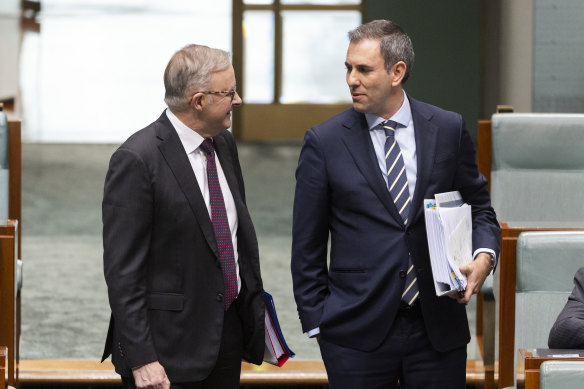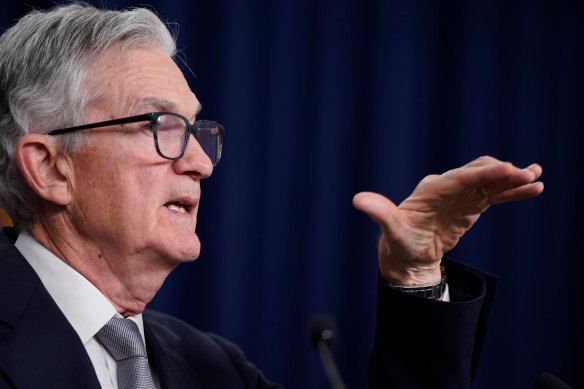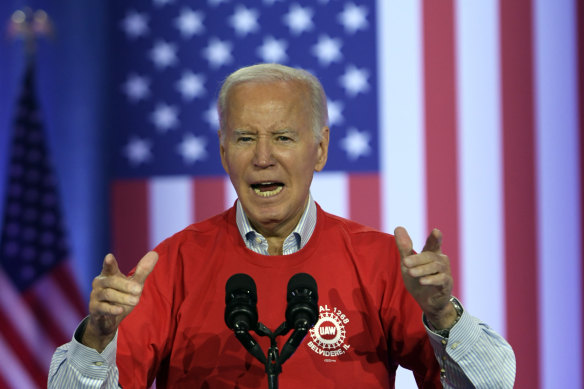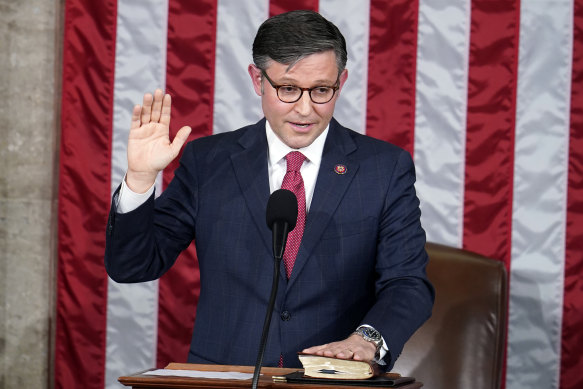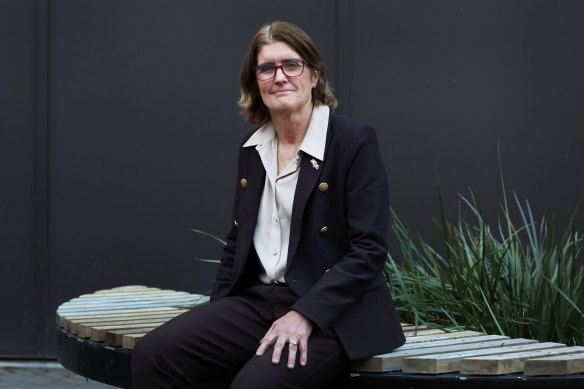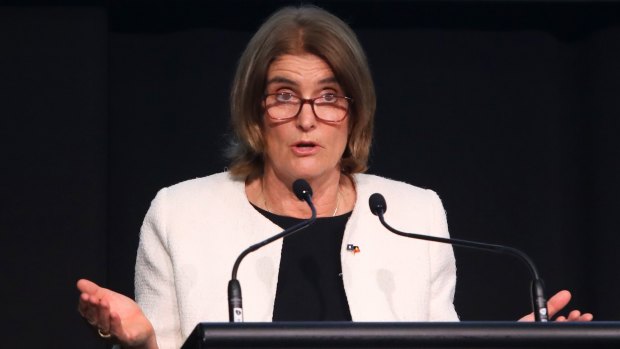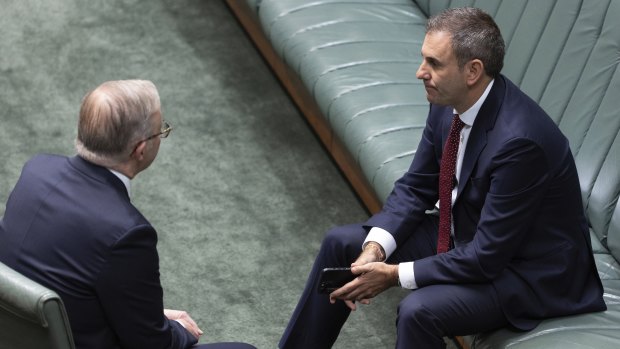The post Why Albanese probably won’t win majority government at the next election appeared first on Crypto World News.
]]>Add articles to your saved list and come back to them any time.
What we’ve come to call the “cost-of-living crisis” has made this an unusually tough year for many people as they struggle to make ends meet. It’s likely to get worse rather than better next year. Which won’t help Anthony Albanese’s chances of being comfortably returned to government in early 2025.
Everyone hates rapidly rising prices and demands the government do something. But I’m not sure everyone understands the paradoxical nature of the usual ways central banks and governments go about fixing the problem. They make it worse to make it make better.
Illustration: Simon LetchCredit: Supplied
In a market economy, when our demand for goods and services exceeds the economy’s ability to supply them, businesses solve the problem by putting up their prices. The economic managers then seek to weaken our demand by squeezing households’ finances so that they can’t spend as much.
As our spending weakens, firms are less able to keep raising their prices without losing sales.
The main way the Reserve Bank puts the squeeze on household spending is by engineering a rise in mortgage interest payments, leaving people with less money to spend on everything else.
A shortage of rental housing has allowed landlords to make big rent increases. Employers have helped the squeeze by ensuring they raise wages by less than they’ve raised their prices. And Treasurer Jim Chalmers has helped by allowing bracket creep to take a bigger tax bite out of wage increases.
Much to discuss: Prime Minister Anthony Albanese and Treasurer Jim Chalmers.Credit: Alex Ellinghausen
All this is why so many people have been feeling the financial heat this year. But even if there are no more interest rate rises to come, the existing pressures are still working their way through the economy, with little sign of relief.
Consumer prices rose by 7.8 per cent over the year to last December, but the annual rate of increase slowed to 5.4 per cent in September. That’s still well above the Reserve’s target of 2 per cent to 3 per cent.
If the Reserve has accidentally hit the economy harder than intended, we could slip into recession next year, causing a big jump in the number of people out of a job, and thus hitting them much harder.
But with any luck, it won’t come to that. And the crazy-lazy way we define recession – a fall in real gross domestic product in two successive quarters – means that growth in the population may conceal the hip-pocket pain many people are feeling.
Consider the case of someone on the very modest wage of $45,000 a year in September 2021. If their wage rose in line with the wage price index, it would have risen by $3300 to $48,300 in September this year.
However, bracket creep, plus the discontinuation of the low and middle income tax offset, raised the average rate of income tax they pay from 9.8¢ in the dollar to 14.2¢. So their tax bill would have grown by $2460.
Now allow for the rise in consumer prices over the two years, and the purchasing power of their disposable income has fallen by about $5290, meaning their “real” disposable income is $4450 a year less than it used to be.
Can you imagine that person being terribly happy with the way their finances have fared under the Albanese government? My guess is, there’ll be growing disaffection with Labor as next year progresses.
If there’s a low-pain way to get inflation back under control, I’ve yet to hear about it.
To help him win last year’s federal election, Albanese made Labor a “small target” by promising very little change, including no change to the stage three income tax cuts, legislated long before the pandemic, to start in July next year.
His game plan had been to spend his first term being steady and sensible, keeping his promises and being an “economically responsible” government. This would get him re-elected with an increased majority and able to implement needed but controversial reforms.
But, through no great fault of his own, he’s had to grapple with the worst surge in the cost of living in decades. If there’s a low-pain way to get inflation back under control, I’ve yet to hear about it.
The trouble set in well before the change of government, and the Reserve Bank began its long series of interest rate rises during the election campaign.
My guess is that Albanese’s hopes of storming back to power at an election due by May 2025 are dashed. But it’s hard to see Peter Dutton winning the election unless he can win back the Liberal heartland seats that went to the teals, which seems doubtful.
So, it’s not hard to see Albanese losing seats and reduced to minority government, dependent on the support of the Greens and teals.
There is, however, one thing he could do to cheer up many voters: rejig the coming tax cuts so the lion’s share of the $25 billion they’ll cost the budget goes not to the high-income taxpayers who’ve had the least trouble coping with living costs, but to those on lower incomes who’ve the most.
Ross Gittins is the economics editor.
Ross Gittins unpacks the economy in an exclusive subscriber-only newsletter. Sign up to receive it every Tuesday evening.
Most Viewed in Business
From our partners
Source: Read Full Article
The post Why Albanese probably won’t win majority government at the next election appeared first on Crypto World News.
]]>The post Bank Of Russia Hikes Rate By 100 Bps appeared first on Crypto World News.
]]>The board of directors of Bank of Russia, headed by Elvira Nabiullina, decided to lift the key rate by 100 basis points to 16.00 percent.
The bank has raised the policy rate by 850 basis points over the last five meetings.
Inflation is forecast to be close to the upper bound of the 7.0-7.5 percent forecast range this year.
Given the current monetary policy stance, annual inflation is expected to ease to 4.0-4.5 percent next year and will stabilize close to 4 percent further on.
“The return of inflation to target in 2024 and its further stabilization close to 4 percent assume that tight monetary conditions will be maintained in the economy for a long period,” the bank said.
Economic growth is projected to outperform its October forecast and exceed 3 percent this year.
Domestic demand helped the economy to register an upward deviation from the balanced growth path.
While rising wages and lending boosted consumer activity, significantly increased profits of companies and fiscal stimulus lifted high investment demand.
Although the consensus view before today’s meeting was that rates would reach a peak of 16.00 percent, more tightening is to come as inflation pressures build further, Capital Economics’ economist Liam Peach said.
The economist expects another 100 basis point of hikes next year, to 17.00 percent.
The central bank had raised its benchmark rate to 20.00 percent from 9.50 percent in February 2022, soon after Russia invaded Ukraine. But the bank gradually reversed this move.
Source: Read Full Article
The post Bank Of Russia Hikes Rate By 100 Bps appeared first on Crypto World News.
]]>The post U.S. Manufacturing Index Indicates Continued Contraction In November appeared first on Crypto World News.
]]>The ISM said its manufacturing PMI came in at 46.7 in November, unchanged from October, with a reading below 50 indicating a contraction. Economists had expected the index to inch up to 47.6.
The unchanged reading came as the new orders index rose to 48.3 in November from 45.5 in October, but the production index slipped to 48.5 from 50.4 in the previous month.
“Demand remains soft, and production execution is slightly down compared to October as panelists’ companies continue to manage outputs, material inputs and — more aggressively — labor costs,” said Timothy R. Fiore, Chair of the ISM Manufacturing Business Survey Committee.
The employment index also edged down to 45.8 in November from 46.8 in October, indicating a slightly faster contraction in employment in the manufacturing sector.
Meanwhile, the report said the prices index jumped to 49.9 in November from 45.1 in October, signifying price stability as a result of energy markets easing.
“The ISM Manufacturing PMI’s weakness in November is concerning given expectations that manufacturing activity would pick up following the end of the UAW strike on October 30,” said Bill Adams, Chief Economist for Comerica Bank.
He added, “Manufacturing is a headwind to the economy in the fourth quarter of 2023, and will likely contribute to a marked slowdown in real GDP growth.”
The ISM is scheduled to release a separate report next Tuesday on U.S. service sector activity in the month of November.
The services PMI is currently expected to creep up to 52.0 in November from 51.8 in October, with a reading above 50 indicating growth.
Source: Read Full Article
The post U.S. Manufacturing Index Indicates Continued Contraction In November appeared first on Crypto World News.
]]>The post The Aussie dollar is weak, except for in this desirable destination appeared first on Crypto World News.
]]>Add articles to your saved list and come back to them any time.
Australian visitors to the United Kingdom and the Eurozone will likely notice their funds are feeling more stretched than usual, with the Australian dollar trading against the pound and euro at levels substantially lower than a year ago.
Our dollar is worth about 52 pence from about 56 pence a year ago after reaching 60 pence, briefly, in September 2022. Against the euro, our dollar is buying about 60 euro cents, from 65 euro cents 12 months ago. As recently as August 2022, our dollar briefly reached almost 70 euro cents.
Japan is one of the few countries where our dollar is buying more than a year ago. Credit: visualspace
A check with the cost-of-living database, Numbeo, attests to the fact that prices of many things – from a regular-sized cappuccino in London to petrol in Rome – are particularly expensive for Australian travellers.
Our dollar is also weak against the US dollar, with our dollar trading at about US66¢, although that is in line with levels a year ago. Five years ago, our dollar was buying about US73¢.
Across the ditch, in New Zealand, our dollar is buying about $NZ1.09, about what it was buying a year ago.
Michael Judge, head of Australia and New Zealand at OFX, a global money transfer company, says it is relative interest rates that are the biggest factor behind currency exchange rates right now.
Interest rates are important drivers of exchange rates as higher interest rates in one country, compared to others, can attract more global investors, which can help strengthen the country’s currency.
The US Federal Reserve has been on a “very determined path to fight inflation and to increase interest rates”, Judge says.
The relatively high interest rates in the United States have increased demand for US dollars by international investors, which has lifted the value of the greenback against most other currencies.
While Australian interest rates have also been rising, they are below that of not only the United States, but also of the United Kingdom and the Eurozone, which is a factor in our dollar’s weakness against the pound, euro and US dollar.
Travellers to the UK and Eurozone will have noticed the weakness of the Australian dollar.Credit: Shutterstock
However, Craig James, the chief economist at CommSec, says Japan is one of the few destinations among those favoured by Australian travellers where the Australian dollar is “looking pretty good”.
Our dollar is buying about 97 yen from 94 yen a year ago. Five years ago, our dollar was buying about 82 yen.
Eating out in Tokyo is much less expensive now for Australian travellers, as is public transport and hotel accommodation.
The yen has been weak against most currencies as interest rates there are negative, as the Japanese central bank attempts to stimulate higher economic growth.
Mahjabeen Zaman, ANZ’s head of FX research, says our dollar’s value against the US dollar has recently moved higher, mostly because markets believe the US Federal Reserve is getting close to the end of its rate-raising cycle.
She is not expecting our dollar to revisit this year’s low of US62¢, and expects the Aussie dollar is unlikely to fall from here.
Zaman is anticipating some appreciation of the Australian dollar against the NZ dollar exchange rate over the next several months, and a “bit of upside” for the Aussie against the pound. She expects little change in the Aussie dollar against the euro.
- Advice given in this article is general in nature and is not intended to influence readers’ decisions about investing or financial products. They should always seek their own professional advice that takes into account their own personal circumstances before making any financial decisions.
Expert tips on how to save, invest and make the most of your money delivered to your inbox every Sunday. Sign up here for our Real Money newsletter.
Most Viewed in Money
From our partners
Source: Read Full Article
The post The Aussie dollar is weak, except for in this desirable destination appeared first on Crypto World News.
]]>The post Mission accomplished? Fed’s inflation success raises hopes for RBA appeared first on Crypto World News.
]]>Add articles to your saved list and come back to them any time.
It may not be quite “mission accomplished,” but the latest inflation data in the US suggests that after the fastest tightening of monetary policy in 40 years, the Federal Reserve has finally brought inflation under control.
The better-than-expected US inflation numbers fit within a global picture of steadily ebbing inflation rates as the lagged effects of rate rises in developed economies over the past year and a half are now flowing through to the official data.
Fed chair Jerome Powell: The US central bank has managed to put a lid on America’s inflation rate.Credit: Bloomberg
The way financial markets responded to the release of the data – the US sharemarket rose nearly 2 per cent, with tech stocks doing even better, bond yields tumbled about 20 basis points and the US dollar was sold off – signals that investors believe the Fed’s work is done and that there will be rate cuts, not more increases, next year.
Headline US inflation flat lined relative to September’s figure and was 3.2 per cent year-on-year. Core inflation (excluding energy and food costs) was 0.2 per cent month-on-month and 4 per cent year-on-year. If housing costs were also excluded, “supercore” inflation was 0.2 per cent month-on-month and 3.75 per cent year-on-year.
Those numbers suggest that, after peaking at 9.1 per cent in June last year, the US inflation rate is tracking nicely towards the Fed’s goal of 2 per cent.
Moreover, it’s doing so without any meaningful pickup in unemployment or damage to the economy, which grew at 4.9 per cent in the September quarter. The prospect of the Fed pulling off the central bankers’ holy grail of a “soft landing” remains alive.
The apparent success of the US central bank’s policies augurs well for central banks elsewhere, including the Reserve Bank, as they have been tracking the Fed’s path, albeit generally not as aggressively.
The Fed has raised US rates 11 times in a cycle that started in March last year, with its federal funds rate rising from 0.1 per cent to a range of 5.25 per cent to 5.5 per cent.
The RBA has raised the cash rate 13 times, starting in May last year, to its current level of 4.35 per cent.
Inflation in Australia peaked at 7.8 per cent in December last year and was running at 5.4 per cent (year-on-year) in the September quarter – it’s trending in the right direction, but is perhaps six months behind where the US, which began its rate-hiking more aggressively than the RBA, is today.
What the US experience indicates is that the cumulative effect of all the Fed’s rate rises is biting.
A similar impact could be expected here, with the instant 1.5 per cent depreciation of the US dollar against the trade-weighted basket of other major currencies – and a 1 cent rise in the Australian dollar – helping the RBA’s cause by making imports a little more expensive if it’s sustained.
It’s not just the tighter monetary policies – with their impact exacerbated by an even stronger rise in yields in bond markets in the past couple of months – that are slowing inflation rates.
The surge in inflation last year has been attributed to the shocks to supply chains generated by the pandemic.
The apparent success of the US central bank’s policies augurs well for central banks elsewhere, including the Reserve Bank.
That has been overlaid by the shifts in trade flows as companies (with urging from some governments) restructured their supply chains to make them less vulnerable and in response to the heightened tensions between the US and China, whose vast and low-cost manufacturing sector had previously anchored most global supply chains.
The massive fiscal response by governments to the pandemic, which left consumers flush with cash, also played its part in the inflation break-outs.
The supply chain issues were resolved some time ago, although the higher costs of the restructured supply lines will continue to flow through.
It also seems that US consumers have exhausted the savings windfall they gained from the fiscal largesse during the pandemic. The financial pressures on households in the US, and here, has increased.
Another, perhaps increasing, downward influence on inflation rates globally could come from China.
With a faltering economy and sluggish global growth, China’s factories have excess capacity. Beijing’s attempts to stimulate have been largely centred on its manufacturing centre, raising the prospect of even more excess capacity and a flood of cheap goods into global markets, lowering prices and reducing inflation rates.
It is ironic that, having been fixated on high inflation rates for nearly two years, central bankers might be more concerned about the rates of disinflation next year.
Certainly, the response of the financial markets to the US data was to rule out any further rate rises in the US in this cycle and to bring forward expectations of rate cuts next year.
While the Fed has maintained – and markets had previously accepted – its “higher for longer” mantra and has been signalling at least one more rate rise this year and no rate cuts until towards the end of 2024 at the earliest, there is now a conviction in the markets that the Fed will be easing rates next year to achieve a soft landing for the economy.
There are some obvious caveats to the view that this relatively brief era of excessive inflation (and the spikes in interest rates in response) is passing.
The most obvious is the volatility of geopolitics. The war in Ukraine, the conflict in the Middle East, the delinking of the US and its allies from China’s economy and America’s attempt to constrain China’s technological capabilities are all threats to global stability.
The potential for steep increases in energy and/or food costs is latent in the conflicts, while the efforts by the US, Europe and others to reduce their dependence on China for some critical products and minerals may also result in increased costs.
In the US, whose economy and financial markets significantly influence other economies, there is also political instability and dysfunction and some difficult and escalating fiscal challenges that could be disruptive for the markets and economy. The risks there, however, appear mostly on the downside – they are more likely to be deflationary than inflationary.
Absent some new development, it is apparent that the trends in inflation in the US and elsewhere are now clear and positive, and that the challenge confronting central bankers next year won’t be combatting excessive inflation rates but – with the lagged effects of past rate rises and the withdrawals of central bank liquidity still flowing through– finessing their monetary policies to avoid unnecessary and avoidable economic damage.
The Business Briefing newsletter delivers major stories, exclusive coverage and expert opinion. Sign up to get it every weekday morning.
Most Viewed in Business
From our partners
Source: Read Full Article
The post Mission accomplished? Fed’s inflation success raises hopes for RBA appeared first on Crypto World News.
]]>The post UK Wage Growth Slows Amid Cooling Labor Market appeared first on Crypto World News.
]]>Excluding bonuses, regular pay growth was 7.7 percent in the three months to September, in line with expectations but slower than the revised 7.9 percent rise in the period through August.
Although this was slightly down on the previous periods, it remains among the highest growth rates since records began in 2001, the ONS said.
Including bonuses, average earnings increased 7.9 percent as the total growth was affected by the civil service one-off payments made in July and August.
Nonetheless, the rate of growth was above economists’ forecast of 7.4 percent.
Private sector regular pay growth slid to 7.8 percent from 8.1 percent in the previous period.
“With wage growth continuing to ease and signs that a further loosening in labor demand lies ahead, higher interest rates appear to be gradually working”, Capital Economics economist Ashley Webb said.
The economist added that wage growth will slow only gradually suggesting that the Bank of England would keep interest rates unchanged at 5.25 percent until late 2024.
BoE’s forecast for private sector wage growth to hit 6.6 percent in March appears to be on track, and if anything, might be beaten on the downside, ING economist James Smith said.
The unemployment rate was 4.2 percent, which was largely unchanged from the previous quarter, data showed.
Payroll employment increased 33,000 from September to 30.2 million. The ONS revised payrolled employee growth from a decrease of 11,000 to an increase of 32,000.
In the three months to October, vacancies decreased by 58,000 on the quarter to 957,000.
In October, the claimant count remained unchanged at 4.0 percent. The number of people claiming jobless benefits increased by 17,800 from the previous month.
Data showed that about 229,000 working days were lost because of labor disputes across the UK in September.
The majority of the strikes were in the health and social work and education sectors.
Source: Read Full Article
The post UK Wage Growth Slows Amid Cooling Labor Market appeared first on Crypto World News.
]]>The post UK Economy Stalls In Q3 As High Inflation Hurt appeared first on Crypto World News.
]]>Gross domestic product posted nil growth in the third quarter after expanding 0.2 percent in the preceding period, data from the Office for National Statistics revealed. The result was better than the expected fall of 0.1 percent.
In output terms, there was a decrease of 0.1 percent in the services sector. The fall offset a 0.1 percent rise in construction.
At the same time, industrial output remained flat following a 0.5 percent drop in August. Output was forecast to gain 0.1 percent.
Manufacturing edged up 0.1 percent, in contrast to August’s 0.7 percent fall. Factory output was expected to climb 0.3 percent.
“High inflation is the single greatest barrier to economic growth – the best way to sustainably grow our economy right now is to stick to our plan and knock inflation back,” Chancellor Jeremy Hunt said.
“The Autumn Statement will focus on how we get the economy growing healthily again by unlocking investment, getting people back into work and reforming our public services so we can deliver the growth our country needs,” Hunt said.
The ONS said an increase in the volume of net trade was offset by falls in business investment, household spending and government consumption.
Household spending fell 0.4 percent in the third quarter largely reflecting lower spending on miscellaneous goods and services. Due to lower expenditure on health and education, government consumption shrunk 0.5 percent.
Gross fixed capital formation logged a monthly fall of 2.0 percent as business investment decreased 4.2 percent. Inventories increased by GBP 1.4 billion in the third quarter, following four quarters of destocking, data showed.
The trade deficit for goods and services was 0.7 percent of nominal gross domestic product.
On a yearly basis, growth in industrial production held steady at 1.5 percent and that in manufacturing output stayed at 3.0 percent.
GDP registered an annual growth of 0.6 percent in the third quarter. This was slightly faster than the forecast of 0.5 percent.
Monthly estimates showed that the economy expanded at a faster pace of 0.2 percent in September after a revised 0.1 percent gain in August, while output was forecast to stagnate.
ING economist James Smith said the most likely path for the economy is stagnation or very modest growth next year, though a recession cannot be ruled out.
The economist said the GDP figures are of limited consequence for the Bank of England and the bank will focus more on services inflation and wage growth figures. Smith expects the next move for Bank Rate to be down with cuts beginning next summer.
Another data from the ONS showed that the visible trade gap narrowed to GBP 14.29 billion from GBP 15.5 billion in August. At the same time, the surplus on services fell marginally to GBP 12.7 billion from GBP 12.8 billion a month ago.
As a result, the total trade deficit decreased to GBP 1.57 billion from GBP 2.69 billion in the previous month.
Source: Read Full Article
The post UK Economy Stalls In Q3 As High Inflation Hurt appeared first on Crypto World News.
]]>The post Days from chaos: The clock is ticking again for a US government shutdown appeared first on Crypto World News.
]]>Add articles to your saved list and come back to them any time.
When Moody’s changed the US credit rating from “stable” to “negative” last Friday it cited “continued political polarisation” as a factor in the downgrade. This week that polarisation could be showcased, yet again.
Former Republican House speaker, Kevin McCarthy, lost his prestigious role last month after, at the 11th hour and with far more Democrats supporting him than Republicans, the House passed a short-term funding bill that averted a shutdown of the US government. The deal he struck with Joe Biden ignited a revolt within the Republicans in the House that saw McCarthy voted out of the Speaker’s position.
The wrangling in Washington highlights how difficult it will be for the US to develop any consensus plan for dealing with its expanding deficits and debt.Credit: AP
That bill gave the House, and the Biden administration, 45 days to come up with a new proposal to fund the government. The deadline expires at midnight on Friday.
In the absence of a new funding plan, many of US federal government’s employees will be stood down without pay while essential workers, including the military, would work without being paid.
Many services would be unavailable, some agencies, like the Securities and Exchange Commission, would be hobbled and private sector companies and contractors that have commercial relationships with the government would be impacted.
After the backlash from conservative Republicans that saw McCarthy lose the Speaker’s role, it took nearly three weeks for the Republicans to agree on his successor, the social ultra-conservative Mike Johnson.
He is now being confronted by the same fierce divisions within his own party’s aggressive right wing and its more moderate centre that toppled McCarthy.
The fiscal and social ultraconservatives – factions like the Freedom Caucus and the Trump-inspired MAGA grouping – want deep spending cuts, radical changes to America’s immigration policies and savage cuts to the Internal Revenue Service’s funding to be attached to any new spending bill. Those are all non-starters for the Democrat-controlled Senate.
Johnson put forward his plan on Saturday.
He’s proposed another temporary funding plan, free of the spending cuts the ultraconservatives want, which would extend funding for the departments of Veterans Affairs, Energy, Agriculture, Transportation and Housing and Development only until January 19. The rest of the government, including the military, would be funded until February 2.
The new House Speaker Mike Johnson is confronting the same problems his predecessor had.Credit: AP
The idea of the “two-step” proposal is that it provide near term breathing space, deferring the moment of shutdown, while keeping the pressure on the Democrats and the Senate to agree the nature of longer-term funding. The absence of spending cuts in the proposal – it would be a “clean” bill, might help Johnson gain some Democrat support in both the House and the Senate.
The proposal has, however, attracted critics and scorn from both Republicans and Democrats, who argue that the two steps envisaged would create the risk of rolling shutdowns. It doesn’t resolve the core issue, the yawning divide between what the conservatives in the House want and what the Democrats who control the Senate will concede.
The dysfunction within the House Republicans adds to, and is probably the major factor in, the polarisation of US politics that Moody’s referred to and which has made the US almost ungovernable.
Johnson’s proposal excludes any funding for Ukraine or Israel which, given both parties have extremely divided views on whether America should be involved in those wars, will be another point of future contention and factional leverage.
Early this month the House did pass a $US14.3 billion ($22.5 billion) aid bill for Israel but with matching funding cuts to the IRS, even though the Congressional Budget Office has said the cuts to the tax office’s funding would reduce tax revenues and increase the US budget deficit by almost $US12.5 billion over the next decade. (The Republican conservatives in the House have consistently wanted to reduce the funding for audits of wealthy Americans and US businesses).
The tying of the aid to Israel to IRS funding cuts doomed the bill in the Senate, just as any broader spending bill that the House Republicans tie to spending cuts, immigration or the IRS would be blocked in that chamber.
It is possible that some Democrats in the House and Senate will support Johnson’s “clean” proposal just to buy more time, although it is equally feasible that the hard-right factions, having already forced him to withdraw two earlier plans for annual spending bills, will revolt again.
The continued wrangling over the funding of the government and the potential for a shutdown that could, according to Goldman Sachs, cost the US 0.2 per cent of its GDP for every week that it lasts, highlights how difficult it will be for the US to develop any consensus plan for dealing with its expanding deficits and debt.
The dysfunction within the House Republicans adds to, and is probably the major factor in, the polarisation of US politics that Moody’s referred to and which has made the US almost ungovernable.
When Moody’s downgraded the outlook for America’s credit rating, not quite joining its peers, Fitch and Standard and Poor’s (who have actually lowered their ratings from America’s former AAA status for similar reasons) it said it had downgraded the outlook rather than the rating because of the United States’ “formidable credit strengths,” the resilience of its economy, the strength of its institutions and the role of the dollar as the world’s reserve currency.
It also, however, said that it saw no immediate pathway for the US to resolve it financial issues.
“In the context of higher interest rates, without effective fiscal policy measures to reduce government spending or increase revenues, Moody’s expects that the US’ fiscal deficits will remain very large, significantly weakening debt affordability.
“Continued political polarisation within US Congress raises the risk that successive governments will not be able to reach consensus on a fiscal plan to slow the decline in debt affordability.”
When Moody’s changed the US credit rating from “stable” to “negative” last Friday it cited “continued political polarisation” as a factor in the downgrade.Credit: Getty
Under the deal McCarthy struck with Joe Biden to lift the ceiling on US debt earlier this year, Biden committed to cutting overall federal government spending by one per cent this fiscal year.
That’s not sufficient, given the steep rise in interest rates on US government debt, to stabilise the US fiscal position but it was a move in the right direction.
With a deficit of $US1.7 trillion in the year to September, or 6.8 per cent of GDP, and projections that the deficit will reach $US2.9 trillion (nearly 7.5 per cent of projected GDP) within a decade without significant cuts to spending and/or increases in revenue, it is apparent that Congress needs to develop a long-term plan for stabilising its finances.
As long as it is populated, and its competing agendas are driven, by ideologues and a lunatic fringe, however, that seems like an unachievable goal.
The Business Briefing newsletter delivers major stories, exclusive coverage and expert opinion. Sign up to get it every weekday morning.
Most Viewed in Business
From our partners
Source: Read Full Article
The post Days from chaos: The clock is ticking again for a US government shutdown appeared first on Crypto World News.
]]>The post Powell Says Fed 'Will Not Hesitate' To Resume Raising Interest Rates appeared first on Crypto World News.
]]>Participating in a policy panel at the 24th Jacques Polak Annual Research Conference in Washington, D.C., Powell acknowledged that U.S. inflation has slowed over the past year but pointed out it remains well above the Fed’s 2 percent target.
“My colleagues and I are gratified by this progress but expect that the process of getting inflation sustainably down to 2 percent has a long way to go,” Powell said.
The Fed chief noted GDP growth is expected to moderate in coming quarters after a strong third quarter but warned stronger growth “could undermine further progress in restoring balance to the labor market and in bringing inflation down, which could warrant a response from monetary policy.”
Powell also said the Fed is “not confident” a stance of monetary policy that is sufficiently restrictive to bring inflation down to 2 percent over time has been achieved.
“We know that ongoing progress toward our 2 percent goal is not assured: Inflation has given us a few head fakes,” Powell said. “If it becomes appropriate to tighten policy further, we will not hesitate to do so.”
He added, “We will continue to move carefully, however, allowing us to address both the risk of being misled by a few good months of data, and the risk of overtightening.”
Powell indicated the Fed will make future monetary policy decisions “meeting by meeting” based on the totality of incoming data and the implications for the outlook for economic activity and inflation.
He reiterated the central bank’s commitment to bringing down inflation, stating the Fed will “keep at it until the job is done.”
Powell’s comments came a little over a week after the Fed left interest rates unchanged for the third time in the past four meetings.
The Fed’s next monetary policy meeting is scheduled for December 12-13, with CME Group’s FedWatch Tool currently indicating an 88.1 percent chance the central bank will once again leave interest rates unchanged.
The FedWatch Tool currently suggests rates are likely to remain unchanged in the coming months until the Fed lowers rates in mid-2024.
Source: Read Full Article
The post Powell Says Fed 'Will Not Hesitate' To Resume Raising Interest Rates appeared first on Crypto World News.
]]>The post UK Consumers Turn Cautious On Christmas Spending appeared first on Crypto World News.
]]>Separate surveys from the BRC and Barclays also showed that consumers are tightening their purse strings as they head into the Christmas shopping season as the high cost of living hurt their spending.
Grocery price inflation slowed to 9.7 percent for the four weeks to October 29, Kantar said. Inflation was 11 percent in the previous report.
Grocery price inflation returned to single digits after 16 months of double digit growth.
“While the drop to 9.7 percent is positive news and something of a watershed, consumers will still be feeling the pinch,” Fraser McKevitt, head of retail and consumer insight, at Kantar, said.
“We’re only seeing year on year price falls in a limited number of major categories including butter, dried pasta and milk.”
During the same four-week period, take-home grocery sales grew by 7.4 percent year-on-year.
Consumer spending on promotions hit 27.2 percent of total grocery sales – the highest level since Christmas last year, Kantar said.
Elsewhere, survey data from the British Retail Consortium suggested that consumers are turning more cautious on spending amid the rising cost of living.
Data from the BRC-KPMG survey, released on Tuesday, showed that retail sales annual growth eased to 2.5 percent in October from 2.7 percent in September.
Food sales grew 7.9 percent year-on-year in the three months to October, while non-food sales shrunk 1.0 percent.
“Whilst consumers are now operating in a lower inflationary environment compared to October last year where inflation peaked at over 11 percent, there is no doubt that the last 12 months have taken a toll on confidence and their ability to spend,” Paul Martin, UK head of retail at KPMG, said.
“Coupled with a higher interest rate environment, dwindling covid savings and the heating coming back on, beleaguered consumers are thinking very carefully about how they spend their money.”
Spending levels are expected to be much more muted this year and the run up to Christmas could be the most challenging one seen since pre-pandemic days, Martin added.
The Barclays survey showed that consumer card spending grew just 2.6 percent year-on-year in October, which was the smallest gain September last year, when it rose 1.8 percent.
Rising energy bills and Christmas costs were to blame for the decline in discretionary spending, Barclays said.
The unreasonably warm weather in October delayed new clothing purchases, the bank added.
However, the Rugby World Cup boosted sales at pubs and bars for the second month in a row and the travel sector performed well as holiday bookings climbed.
Spending on non-essential items rose only 2.0 percent, which was the weakest gain since September 2022.
Almost half, 47 percent, of consumers plan to reduce discretionary spending to cope with higher energy bills throughout the autumn and winter.
Most common cut-backs included ordering takeaways, eating out at restaurants, and buying new clothes and accessories for day-to-day wear.
UK consumers are pulling back from discretionary spending and increasingly worried about their future ability to spend, Jack Meaning, chief UK economist at Barclays, said.
Source: Read Full Article
The post UK Consumers Turn Cautious On Christmas Spending appeared first on Crypto World News.
]]>The post Another rate rise? It’s the last thing we need appeared first on Crypto World News.
]]>Add articles to your saved list and come back to them any time.
The Reserve Bank has spoken, and interest rates are up another 25 basis points. It’s a bad decision.
I am one of 32 “experts” who are surveyed each month for their prediction on the next monthly rate movement, and this month I was in the minority; just 30 per cent of us forecast no change. It was not so much a prediction from me as it was a fervent wish. The last thing we need is another rate rise.
Michele Bullock, deputy governor of the Reserve Bank of Australia (RBA).Credit: Bloomberg
Central banks around the world are trying to combat inflation with one blunt instrument: interest rate control. They have been sold on the idea that inflation should be kept within a specific target band, and all their efforts are directed to keeping it there, but the problem is that it’s a concept with no statistical validity.
Many people are flabbergasted to learn that the Reserve Bank of Australia’s 2 per cent target was created out of thin air in 1990 by the Reserve Bank of New Zealand, and has no basis in any sort of academic study whatsoever.
In fact, it appears to have come from an off-the-cuff remark made during a TV interview with Roger Douglas, New Zealand’s finance minister at the time, who said that he’d “ideally” want an inflation rate between 0 per cent and 1 per cent.
The 2 per cent you hear today as a target was originally intended as a “boundary”, and nothing more, for inflationary bias, which was estimated to be just 0.75 per cent at the time. Following New Zealand’s lead, other countries, including Australia, Canada and England, adopted the 2 per cent inflation target. The US Federal Reserve officially adopted the 2 per cent inflation target in January 2012 under the leadership of then-chairman Ben Bernanke.
[Governments] are exacerbating the problem. They [have] massive infrastructure projects everywhere … and migrants arrive at a rapid rate.
The RBA is in challenging territory. It wants to see inflation drop, but increasing the loan repayments of average families will not affect inflation. We have imported inflation because of the wars in Ukraine and the Middle East. There are massive challenges in the building industry due to shortages and rising costs: architects tell me their developer clients who have approvals are not prepared to start building because the build costs are potentially so high the deals no longer work.
And what are governments doing? They are exacerbating the problem. They are pouring money into the system with massive infrastructure building projects everywhere and keeping demand high with migrants arriving at a rapid rate.
This puts huge pressure on the already overcrowded rental market. We now have the ridiculous situation where central banks are putting the brakes on, while the rest of the government does everything they can to keep their foot on the accelerator.
Despite 12 previous rate hikes in the current cycle, the anti-inflation battle is far from over. Last month the latest Australian inflation figures were released for the September quarter, with mixed news. Quarterly inflation rose from 0.8 per cent to 1.2 per cent, while the annual rate (rolling 12 months) fell from 6.1 per cent to 5.4 per cent. It’s going to be a slow road to the RBA target.
JB Hi Fi are among big companies to report declining sales.Credit: Will Willitts
Certainly, the rate rises in the last cycle have dampened the enthusiasm of shoppers – companies like Harvey Norman and JB Hi-Fi report declining sales, but they have had little effect on the big picture. Our inflation is structural.
A big problem is unemployment. Job markets are still very tight here and around the world: wages are rising everywhere. Rising wages without an equivalent rise in output just push prices higher, and feed the inflationary spiral.
So where to from here? It’s anybody’s guess. The Reserve Bank can’t keep crushing working families and small businesses in a futile attempt to stop inflation but they no sign of stopping. Sadly, I feel things will get much worse before they get better.
Noel Whittaker is the author of Retirement Made Simple and other books on personal finance. Email: [email protected]
- Advice given in this article is general in nature and is not intended to influence readers’ decisions about investing or financial products. They should always seek their own professional advice that takes into account their own personal circumstances before making any financial decisions.
For expert tips on how to save, invest and make the most of your money, delivered to your inbox every Sunday, sign up for our Real Money newsletter here.
Most Viewed in Money
From our partners
Source: Read Full Article
The post Another rate rise? It’s the last thing we need appeared first on Crypto World News.
]]>The post More economic pain is coming, with women set to bear the brunt of it appeared first on Crypto World News.
]]>Add articles to your saved list and come back to them any time.
The money is once again on a Melbourne Cup rate rise from the Reserve Bank of Australia as the latest data points to an economy running much hotter than hoped.
As mortgage holders brace for another hit, questions will be rightly asked about whether there isn’t more the Albanese Government could be doing to rein in inflation.
RBA governor Michele Bullock and the board will meet on Tuesday to discuss interest rates.Credit: Bloomberg
On Tuesday, the RBA will consider the latest rounds of data on spending and employment. The latest read on inflation showed it running at 5.4 cent annually. Unemployment remains low at 3.6 per cent, while retail spending has ticked up by 2 per cent compared with the same time last year.
All of this paints a combined picture of an economy that is growing faster than necessary to bring inflation within the RBA’s target range of 2 to 3 per cent by the end of next year.
There are two options for slowing economic growth – higher interest rates or tighter fiscal policy. Whereas monetary policy like interest rate rises hits households with mortgages, it is a blunt tool. Fiscal policy, on the other hand, can be more nuanced and targeted in who it impacts.
Australia, we need to talk about tax.
To date, the federal government has played a role in slowing the economy, returning a $22.1 billion surplus in the last financial year. However, as it gets ready to deliver $254 billion in Stage 3 tax cuts next July, there should be real questions asked about how such largesse can be justified in the current economic climate.
The Stage 3 tax cuts put more money back into the pockets of middle and high-income households – that is, households with a lower need for income relief. The changes do this by removing the middle tax bracket of income taxation for those earning between $120,000 and $180,000, flattening the progressive income structure. They increase the top tax bracket to $200,000 and reduce the marginal tax rates for incomes between $45,000 and $200,000 to 30 per cent.
When they were announced back in 2019, the Stage 3 tax cuts were critiqued by economists who highlighted the folly in announcing such large reform so far out from their introduction. The Grattan Institute noted that it was unclear whether the tax cuts were affordable or the right size and shape for our economy, and that they would have the effect of crowding out meaningful tax reform into the future.
We now find ourselves in the position where the Stage 3 tax cuts stand to increase demand in the economy when the RBA is trying to lower it – acting directly against monetary policy and meaning households will face higher interest rates for longer. The changes will also add to structural issues within the budget, highlighted in the government’s own Intergenerational Report.
Prime Minister Anthony Albanese and Treasurer Jim Chalmers have said they will keep the Stage 3 tax cuts. Credit: Alex Ellinghausen
But rather than meaningfully addressing these issues, the government places itself in a position of prosecuting the case for tax changes that its own analysis does not support. And we find ourselves further away from any conversation about the structural tax settings needed to fund increasing levels of government provision.
We also know households are hanging on by a whisker. August 2023 polling from the ANU showed an uptick in the number of Australians who say they are finding it difficult to get by on their current income.
Because of their skew to middle and upper incomes, the Stage 3 tax changes will go mainly to male, high-income taxpayers. These effects go directly against the Albanese Government’s agenda to boost the economic equity of women.
Next month, the government will release its mid-year economic statement as a prelude to the May 2024 budget. It is the next significant piece in the Albanese Government’s legacy, following the Voice defeat in October that was a personal priority of the prime minister.
The government is only too aware that this moment represents an inflection point about its legitimacy and its agenda. It will set the course for the public’s understanding of the Albanese Government and what it exists to do.
There are real questions about social and economic equity that the government is making by proceeding with a stimulatory and regressive tax change.
It’s hard to see why a government that genuinely tries not to walk past social problems without trying to fix them feels so bound to hold the line on this. The Treasurer himself has said that the tax cuts will impose a growing cost on a budget already struggling under the weight of increasingly expensive programs. At what cost is it staying the course?
Dr Emily Millane is a partner at Impact Economics and Policy and a Senior Fellow at Melbourne Law School at the Centre for Commercial Law.
The Opinion newsletter is a weekly wrap of views that will challenge, champion and inform your own. Sign up here.
Most Viewed in Business
From our partners
Source: Read Full Article
The post More economic pain is coming, with women set to bear the brunt of it appeared first on Crypto World News.
]]>
